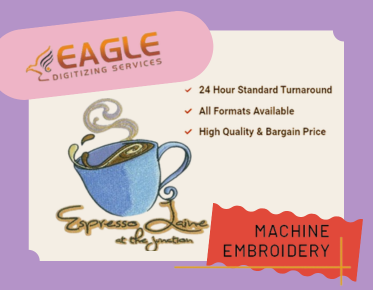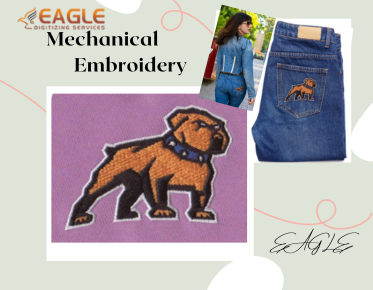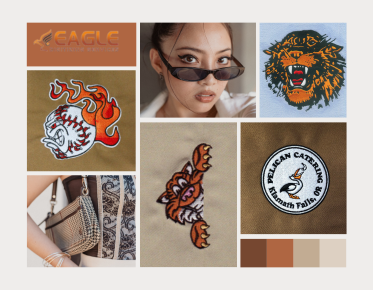Enhance Custom T-Shirts with Latest Embroidery Digitizing Tech
Custom t-shirts have transcended beyond mere garments to become a canvas for personal expression and branding. They reflect individuality, commemorate events, and serve as powerful marketing tools. In the fashion industry, where uniqueness is celebrated, custom t-shirts offer an avenue for designers and consumers alike to showcase their creativity and personal style.
The Role of Embroidery Digitizing in Custom Apparel Design
Embroidery digitizing bridges the gap between creative concepts and tangible designs. This process converts artwork into a digital file that embroidery machines can read, translating intricate designs into stitched reality. Embroidery adds texture, dimension, and a touch of elegance to t-shirts, making them stand out in a sea of printed apparel.
Choosing the Right Embroidery Digitizing Software
Top Features to Look for in Embroidery Digitizing Software
When selecting embroidery digitizing software, consider features like ease of use, comprehensive stitch libraries, and robust editing capabilities. Advanced features such as auto-digitizing, 3D visualization, and vector image support can significantly enhance the design process. Look for software that offers seamless integration with your embroidery machine and provides ongoing updates and support.
Comparing Popular Embroidery Digitizing Software Options
Popular software solutions include Wilcom, Hatch, and Brother's PE-Design. Wilcom is known for its professional-grade tools and extensive features, making it a favorite among industry experts. Hatch offers user-friendly features ideal for beginners and small businesses. Brother’s PE-Design provides a balance of advanced features and affordability, catering to both enthusiasts and professionals.
Cost vs. Value: Investing in Quality Digitizing Software
While high-end software may come with a significant price tag, the investment often pays off in the long run. Quality software offers better precision, fewer errors, and enhanced design capabilities. Consider the long-term value, including improved efficiency, design quality, and support services, when evaluating the cost of digitizing software.
Designing for Embroidery: Tips and Tricks
Creating Artwork Suitable for Embroidery
Not all designs translate well to embroidery. Simple, bold lines and distinct shapes work best. Avoid overly intricate details and thin lines that may not stitch cleanly. Vector images are preferred as they can be easily scaled without losing quality, ensuring a crisp and clear final product.
Understanding Stitch Types and Their Impact on Design
Different stitch types serve various purposes in embroidery. Satin stitches are ideal for smooth, curved lines, while fill stitches cover large areas with a textured effect. Running stitches are perfect for outlines and delicate details. Understanding these stitch types helps in creating designs that are both visually appealing and technically feasible.
Simplifying Complex Designs for Better Embroidery Results
Complex designs can be simplified by reducing the number of colors, removing unnecessary details, and focusing on the core elements. This not only makes the digitizing process easier but also ensures a cleaner and more professional-looking embroidered design. Simplification also reduces the risk of thread breaks and other technical issues during stitching.
Innovative Design Techniques Using Embroidery Digitizing
Incorporating 3D Puff Embroidery for a Unique Look
3D puff embroidery employs foam behind the threads to provide a raised, three-dimensional impression. This technique adds depth and texture to designs, making them pop. It's particularly effective for bold, simple logos and text, giving t-shirts a standout, premium appearance.
Using Appliqué to Add Texture and Color
Appliqué involves stitching pieces of fabric onto the t-shirt to create designs. This technique adds texture and allows for the incorporation of different materials and colors, resulting in rich, multi-dimensional designs. Appliqué is perfect for large, bold designs and can significantly reduce the stitch count and production time.
Exploring Gradient Embroidery for Smooth Color Transitions
Gradient embroidery, or color blending, uses varying thread colors to create smooth transitions and shading. This technique adds a realistic and artistic touch to designs, making them look painted or airbrushed. Gradient embroidery is ideal for designs that require subtle color changes and highlights.
Maximizing Color and Detail with Advanced Digitizing
Best Practices for Color Blending in Embroidery
To achieve seamless color blending, use threads in gradual shades and blend them by overlapping stitches. Start with the lightest color and layer darker shades on top. This technique requires meticulous planning and precision but results in stunning, lifelike designs.
Enhancing Fine Details with Micro Embroidery Techniques
Micro embroidery uses fine threads and small stitches to capture intricate details. This technique is perfect for detailed logos, text, and complex designs. It requires advanced digitizing skills and high-quality machines to ensure precision and clarity.
Using Multiple Thread Colors for Vibrant Designs
Incorporating multiple thread colors can bring designs to life. Use contrasting colors for bold effects or complementary shades for subtle depth. Plan the color sequence carefully to avoid thread changes that could affect the design’s flow and appearance.
Customizing T-Shirts with Personalized Embroidery
Adding Monograms and Initials for a Personal Touch
Monograms and initials add a personal touch to custom t-shirts, making them perfect gifts or keepsakes. Choose elegant fonts and place them in visible areas like the chest or sleeve. Personalized embroidery enhances the perceived value and sentimentality of the t-shirt.
Designing Custom Logos and Branding for Businesses
Custom logos and branding on t-shirts serve as mobile advertisements. Ensure the logo is clear, readable, and represents the brand's identity. Embroidery adds a touch of sophistication, making branded t-shirts suitable for corporate events, staff uniforms, and promotional giveaways.
Creating Themed T-shirts for Events and Special Occasions
Themed t-shirts for events like weddings, reunions, or corporate outings can be enhanced with embroidery. Use relevant motifs, dates, and names to commemorate the occasion. Embroidered designs are durable, ensuring the t-shirts remain a cherished memory long after the event.
Innovative Embroidery Effects for Custom T-Shirts
Metallic and Reflective Threads for a Modern Look
Metallic and reflective threads add a modern, high-tech look to t-shirt designs. These threads catch the light and shimmer, creating eye-catching effects. They are perfect for logos, text, and decorative elements, adding a touch of glamour and sophistication.
Glow-in-the-Dark Embroidery for Fun and Function
Glow-in-the-dark threads add a playful and functional element to t-shirts. These threads absorb light and emit a soft glow in the dark, making them ideal for children's wear, sportswear, and novelty items. Glow-in-the-dark embroidery is both fun and practical, enhancing visibility in low-light conditions.
Embossed and Raised Effects for a Premium Finish
Embossed and raised effects add a tactile dimension to t-shirts, creating a premium finish. These techniques involve layering threads or using foam to create a raised surface. They add depth and interest to designs, making them stand out both visually and physically.
Integrating Embroidery with Other Customization Methods
Combining Embroidery with Screen Printing
Combining embroidery with screen printing offers the best of both worlds: the texture and durability of embroidery with the vividness and detail of screen printing. Use embroidery for logos and text, while screen printing can cover larger, more intricate designs. This hybrid approach creates visually stunning t-shirts.
Using Heat Transfers and Patches with Embroidery
Heat transfers and patches can be combined with embroidery to add variety and versatility to t-shirt designs. Heat transfers allow for detailed, full-color images, while patches add a vintage or athletic touch. Integrating these methods with embroidery enhances the overall design and offers unique customization options.
Mixing Embroidery with Direct-to-Garment Printing
Direct-to-garment (DTG) printing produces photo-quality images directly onto fabric. Combining DTG with embroidery can highlight certain elements, adding texture and depth to printed designs. This technique is ideal for creating multi-dimensional, eye-catching t-shirts that stand out.
Optimizing the Digitizing Process for Better Results
Tips for Efficiently Setting Up Your Digitizing Workflow
Streamline your digitizing workflow by organizing your design files, setting up templates for common projects, and automating repetitive tasks. Use high-quality vector images as your starting point and plan your stitch path to minimize thread changes and maximize efficiency.
Common Mistakes to Avoid in Embroidery Digitizing
Avoid common digitizing mistakes such as poor stitch density, incorrect stitch types, and improper pathing. These errors can lead to thread breaks, puckering, and misalignment. Test your designs on similar fabrics before production to catch and correct any issues early.
Troubleshooting Digitizing Issues: A Quick Guide
When troubleshooting digitizing issues, check for common problems such as tension settings, thread quality, and machine calibration. Use software features to preview and simulate designs, and make adjustments as needed. Keep a log of issues and solutions to streamline future projects.
Ensuring Quality and Consistency in Embroidery
Setting Quality Standards for Embroidered T-Shirts
Establish clear quality standards for your embroidered t-shirts, including stitch density, thread quality, and design accuracy. Regularly review samples and finished products to ensure consistency and adherence to these standards. High-quality embroidery enhances the overall appeal and durability of custom t-shirts.
Regular Maintenance and Calibration of Embroidery Machines
Regular maintenance and calibration of embroidery machines are crucial for consistent quality. Follow the manufacturer's instructions for cleaning, lubrication, and part replacement. Periodically calibrate the machine to ensure accurate stitch placement and tension, preventing issues that could affect the final product.
Conducting Quality Checks and Final Inspections
Conduct thorough quality checks and final inspections on each embroidered t-shirt. Check for loose threads, design alignment, and overall finish. Address any issues before the t-shirts are packaged and shipped to ensure customers receive a high-quality product.
Sustainability in Embroidery Digitizing
Eco-Friendly Embroidery Threads and Materials
Choose eco-friendly threads and materials to reduce the environmental impact of your embroidery projects. Opt for organic cotton threads, recycled polyester, and water-based inks. These sustainable options maintain high-quality standards while promoting environmental responsibility.
Reducing Waste in the Digitizing Process
Minimize waste in the digitizing process by optimizing design layouts and using software features to reduce thread usage. Recycle or repurpose scrap materials and threads. Implementing efficient production practices not only benefits the environment but also reduces costs.
Sustainable Practices for Custom T-Shirt Production
Adopt sustainable practices throughout the custom t-shirt production process, from sourcing materials to packaging. Use energy-efficient machines, reduce water consumption, and minimize chemical use. Promote sustainability as part of your brand identity to attract eco-conscious consumers.
Marketing and Selling Custom Embroidered T-Shirts
Creating a Unique Brand Identity with Custom Embroidery
Custom embroidery can help create a unique brand identity. Develop distinctive designs that reflect your brand’s values and aesthetic. Consistently use these designs across your products to build brand recognition and loyalty.
Effective Marketing Strategies for Embroidered Apparel
Effective marketing strategies include showcasing your embroidered apparel on social media, collaborating with influencers, and attending trade shows. Highlight the quality, customization options, and unique features of your products. Use professional photos and engaging content to attract and retain customers.
Leveraging Social Media to Showcase Your Designs
Leverage social media platforms like Instagram, Facebook, and Pinterest to showcase your embroidered t-shirts. Share behind-the-scenes content, design inspiration, and customer testimonials. Engage with your audience through interactive posts, live demonstrations, and exclusive promotions.
Enhancing custom t-shirt designs with the latest embroidery digitizing technology involves understanding the basics, choosing the right software, and employing innovative design techniques. Quality and consistency are paramount, along with sustainable practices and effective marketing strategies.
Embroidery digitizing offers endless possibilities for creativity and customization. Don't be scared to try out new techniques, materials, and designs. Each project is an opportunity to push the boundaries and create something truly unique.



